UEi Test Instruments CD200 Owner's manual
- Category
- Motion detectors
- Type
- Owner's manual

CD200
Combustible Gas Leak Detector
Combustible
Gas Leak Detector
ALARM
ALARM SET
READY
OFF ALMON
T
I
C
A
D
J
U
S
T
ALARM
1 LITE
CD200
1-800-547-5740
www.ueitest.com • email: [email protected]
INSTRUCTION MANUAL
ENGLISH

The CD200 has a long, slim gooseneck probe and a bright LED tip light to find leaks in tight areas. It’s adjustable
alarm, easy one-hand operation and impact resistance storage case add up to value and convenience
Features include
• Adjustable tick rate to locate leaks quickly and easily
• Visual leak detection by LED indicators
• Separate user adjustable alarm for pre-determined level detection
• Precision sensor detects even the smallest leaks
• Tip light illuminates search area
• Fast response of less than two seconds to 40% LEL*
• Includes earphone
INTRODUCTION
SAFETY TIPS
Before using this Instrument, read all safety information carefully. In this manual the word “WARNING” is used
to indicate conditions or actions that may pose physical hazards to the user. The word “CAUTION” is used to
indicate conditions or actions that may damage this instrument.
If you are using your CD200 as a result of a service call, chances are someone has either smelled a combustible
gas leak or someone has reason to believe gas may be leaking. While your CD200 is designed to function without
producing sparks or otherwise igniting the gasses it detects, the environment you are responding to probably has
no such safeguards. Most combustible gas leaks are noticed long before concentration levels build up to the point
that explosion hazards exist.
WARNING!
If you feel an explosion hazard exists:
• Arrange for evacuation of people in the area
• Call proper authorities from a safe location
• Shut off gas source if possible
• Ventilate enclosed areas if possible to do so without risk of ignition
• DO NOT switch power switches on in area of question
As a matter of routine, ventilate the area you plan to work in. Ventilation will help ensure the gas does not
accumulate in large volume where it can attain its Lower Explosive Limit (LEL)*.
LEL: Lower Explosive Limit - The point at which a combustible gas, when mixed with air, has developed the minimum
concentration to combust when exposed to a source of ignition. The LEL is usually stated as a percentage of gas in air,
as a fuel-air-ratio, or as parts-per-million (PPM) in air.

3
Combustible
Gas Leak Detector
ALARM
ALARM SET
READY
OFF ALMON
T
I
C
A
D
J
U
S
T
ALARM
1 LITE
CD200
10
11
12
13
1
2
5
3
4
6
7
8
9
14
1. Earphone Jack
2. LED Gas Concentration Indicators
3. Amplified Tic and Alarm Speaker
4. Alarm Light
5. Probe Clip
6. Ready Light (Power-On)
7. Power/Alarm Slide Switch
8. Tic Rate (Sensitivity) Adjustment
9. Alarm Mute Push button
10. LED Tip Light
11. Sensor Tip Guard
12. Sensor (internal)
13. Gooseneck Probe
14. Alarm Calibration/Variable Position Selector
INTERNATIONAL SYMBOLS
CONTROLS AND INDICATORS
Dangerous Voltage Ground
AC Alternating Current
Warning or Caution
DC Direct Current
Double Insulation
(Protection Class ll)
Either AC or DC Fuse
Not Applicable to
Identified Model
Battery

4
The CD200 runs through a one-minute warm-up and self-zeroing sequence when it is first turned on in fresh air.
During this warm-up period the instrument typically responds by:
• Turning on the READY light - glows steadily
• Quickly increasing its tic rate, as though it were sensing a combustible gas, then gradually returning to
a slower tic rate
• Lighting the LED gas concentration indicators, which rise and fall in concentration indicators,
also in concert with the tic rate
Each time the instrument is put into service, you should conduct a quick functional test. Simply expose the sensor
to a known leak, like a cigarette lighter, or pass the probe over a drop of combustible fluid.
After the initial warm-up, the instrument can be used to detect combustible gasses. When the sensor in the probe
tip detects a combustible gas, the tic rate will increase and the LED gas concentration indicators will begin to
light. As the concentration of gas increases so does the tic rate.
If the READY light is flashing, the batteries are low. They should be replaced immediately. Low batteries will
adversely affect the instrument’s reliability. See the Maintenance section for replacement procedures.
Use the alarm by sliding the Power/Alarm slide switch into the ALM position. If the gas concentration reaches a
preset level, the instrument sounds a warbling tone while the ALARM light flashes.
If the situation calls for quiet operation, or if background noise makes it difficult to hear the built-in speaker,
you can use an earphone. The jack is at the top of the instrument. Note that listening to the alarm or tic through
the earphone is very loud.
Adjusting the Tic Rate
The tic rate tells you when the sensor (in the tip of the instrument) is getting close to a leaking gas. You can
control the tic rate using the rotary wheel in the center of the instrument.
Move the wheel clockwise
to increase the frequency
Move the wheel counter-clockwise
to decrease the frequency
INSTRUCTIONS
A tic rate of 4 to 8 tics per second, in fresh air, is
typical. As the sensor comes near a combustible gas
source, the tic rate increases. In order to isolate the
source of a leak, you may need to move the wheel
counter clockwise, decreasing the sensitivity, as the
sensor moves closer.
The LED Indicators
There are a total of six LED indicators along the left side of the instrument. Two green, two orange, and two red,
which indicate the relative concentration of gas detected. These respond in direct proportion to the tic rate.
When the tic rate is initially set (with no combustible gas being detected), the bottom most (green) LED should be
flashing on and off rapidly. As the sensor moves closer to the source of a gas leak, the LED indicators will light in
sequence from bottom to top.
Setting the Alarm
The alarm functions independently of the tic rate. Use it to separate significant leaks from background contamination.
Slide the Power/Alarm switch to the ALM position, and a warbling tone will sound when a preset level of combustible
gas is detected. The thumb-wheel on the bottom of the instrument allows you to use either the factory calibrated
setting of .5% methane in air, or increase the sensitivity to your own set-point.

5
To select the factory calibrated setting:
Turn the thumb-wheel fully clockwise. You will feel a click when it reaches the end of its motion and stop at this
factory setting.
To increase the alarm’s sensitivity:
Turn the thumb-wheel counter-clockwise. As the thumb-wheel moves out of the factory set calibrated position you
will feel a click.
To set your own alarm point:
1. In a controlled environment, create the circumstance you want the alarm to report (a pinhole leak
for example).
2. Allow your instrument to warm up for one minute in the ALARM mode.
3. Move the sensor tip over the controlled leak.
4. Move the thumb-wheel slowly until the alarm sounds.
5. Move the sensor away from the leak to ensure the alarm stops.
6. Verify repeatability - Ensure the alarm sounds when the sensor is returned to the leak source.
7. The instrument is ready for its application - Repeat these steps if the thumb-wheel is moved.
The alarm mute button: located below the tic rate adjustment knob, will silence the alarm as long as it is depressed.
The alarm lamp will continue to function with the alarm mute depressed.
The alarm will continue to sound for a short period after the probe is removed from the leak source due to residual
gas in the sensor cavity. The duration of the alarm will be directly related to the concentration of combustible gas the
sensor was exposed to.
MAINTENANCE
Cleaning
Certain soaps are detected by the CD200. Check your sensitivity before using any soap, and remove as much of
the residual as possible with a damp cloth.
DO NOT allow moisture to directly contact the sensor. Remove the sensor tip guard prior to cleaning it. Rinse
and dry thoroughly before replacing.
Replacing the Batteries
Replace your 1.5 volt AA alkaline batteries when:
• The green READY light begins to strobe (flash on and off)
• No light or other activity occurs upon turning the instrument on
To replace the batteries:
1. Lay the instrument face-down on a clean, flat surface.
2. Remove the battery cover. Apply upward pressure to the tab at the bottom of the battery
cover while lifting it out.
3. Remove the batteries using a coin or screwdriver, if necessary, to pry them out.
4. Replace all four batteries with new ones.

6
Replacing the Sensor
Although the sensor is designed to offer many years of reliable service, it may become inoperable if it is submerged in
liquid or otherwise physically damaged.
To replace sensor:
1. Turn the instrument off
2. Remove the upper tip guard by pressing and lifting straight up from
the alignment notch that separates the two halves of the tip guard.
3. Move the tip-light out of the way. This is a sturdy component, but use
caution bending its leads.
4. Pull the sensor straight up from its tip housing.
5. Relace the sensor, pressing it straight in.
6. Reassemble in reverse order.
Sensor
Calibration
The pre-set alarm threshold can be calibrated to any setting from 0 to 40% of LEL (methane in air) by the UEi
service center, or by other facilities having calibration gas standards.
To ensure your instrument is performing at its peak, send it to the UEi service center or a qualified instrument
calibration facility for annual calibrations.
*The tip light is not required for operation, but should be removed by clipping the leads near their base if the instrument is going to be
used without it.
This unit contains no user serviceable parts beyond those listed in this table. In the event your instrument is
physically damaged or does not function properly after taking the listed action, please return the instrument to
UEi following the warranty and service instructions.
If I See This Malfunction I Should Check Corrective Action
Instrument does not turn on
Battery voltage Replace low batteries
Mode switch position Place firmly in ON or ALM position
Instrument does not tic after it is
switched on, but lights work
Tic rate adjustment
Increase tic rate by turning
knob clockwise
Earphone jack
Remove earphone plug or debris inserted in
receptacle
Appropriate indicators do not light
Battery voltage Replace low batteries
Tic rate adjustment
Increase tic rate by turning
knob clockwise
The tic rate does not increase when
the sensor is exposed to combustible
gas
Airflow to sensor Clear restriction
Sensor connection Lit sensor out and replaced firmly
Sensor contamination Replace sensor
Tic rate remains fast after warm up Sensor contamination Replace sensor
Alarm does not stop sounding when
instrument is used in fresh air
Constant fast tic and visual
indicators
Replace sensor
Proper alarm
sensitivity setting
Adjust sensitivity clockwise
The green READY light strobes or flashes Battery voltage Replace low batteries
Tip light does not shine Physical damage *Return for repair

7
Gasses Detected
The CD200 detects a wide variety of gasses, including some toxic gasses, and nuisance vapors. The following
lists represents only a portion of the more common gasses it will detect.
Combustible:
Alcohol Butane Gasoline Solvents
Thinners Propane Combustible Refrigerants Natural Gas
Volatile jet fuel Methane Naphtha Acetylene
Other:
Acetone ammonia Smoke Hydrogen Sulfide Steam
SPECIFICATIONS
Size 8 3/4” x 3 1/4” x 2 1/2” (Add 1” to height and width to account for coiled probe)
Probe length 18” (46 cm)
Weight: Batteries installed 16.0 oz. (450g)
Power requirements Four AA alkaline batteries
Average battery life Approximately 12 hours (continuous use)
Sensitivity <50 PPM methane in air
Sensor Solid state conductivity (semiconductor)
Duty cycle Continuous
Typical response time Less than 2 seconds for maximum response with 40% LEL methane in air stimulus
Typical recovery time Less than 4 seconds recovering from 40% LEL methane in air
Warm up period One minute average
Alarm Adjustable from 10 to 40% LEL - methane in air (Can be calibrated for other gasses)
Visual level indicators
Six tic rate scaled LED indicators, changing with gas concentration levels from green to red
(including relative, not specific quantities)
Operating Conditions
To ensure accurate readings from your CD200, use it only when ambient air is within this range:
Temperature: 32 to 120˚F
Humidity: 10 to 90% RH (non condensing)

WARRANTY
The CD200 is warranted to be free from defects in materials and workmanship for a period of three years from the
date of purchase. If within the warranty period your instrument should become inoperative from such defects, the
unit will be repaired or replaced at UEi’s option. This warranty covers normal use and does not cover damage which
occurs in shipment or failure which results from alteration, tampering, accident, misuse, abuse, neglect or improper
maintenance. Batteries and consequential damage resulting from failed batteries are not covered by warranty.
Any implied warranties, including but not limited to implied warranties of merchantability and fitness for a
particular purpose, are limited to the express warranty. UEi shall not be liable for loss of use of the instrument or
other incidental or consequential damages, expenses, or economic loss, or for any claim or claims for such
damage, expenses or economic loss. A purchase receipt or other proof of original purchase date will be required
before warranty repairs will be rendered. Instruments out of warranty will be repaired (when repairable) for a
service charge. Return the unit postage paid and insured to:
1-800-547-5740 • FAX: (503) 643-6322
www.ueitest.com • Email: [email protected]
This warranty gives you specific legal rights. You may also have other rights which vary from state to state.
DISPOSAL
CAUTION: This symbol indicates that equipment and its accessories shall be subject to separate collection
and correct disposal.
CLEANING
Periodically clean your meters’ case using a damp cloth. DO NOT use abrasive, flammable liquids, cleaning
solvents, or strong detergents as they may damage the finish, impair safety, or affect the reliability of the
structural components.
STORAGE
Remove the batteries when instrument is not in use for a prolonged period of time. Do not expose to high
temperatures or humidity. After a period of storage in extreme conditions exceeding the limits mentioned in the
General Specifications section, allow the instrument to return to normal operating conditions before using it.
Copyright © 2017 Kane USA Inc. All Rights Reserved. CD200-MAN 11/17
PLEASE
RECYCLE
-
 1
1
-
 2
2
-
 3
3
-
 4
4
-
 5
5
-
 6
6
-
 7
7
-
 8
8
UEi Test Instruments CD200 Owner's manual
- Category
- Motion detectors
- Type
- Owner's manual
Ask a question and I''ll find the answer in the document
Finding information in a document is now easier with AI
Related papers
Other documents
-
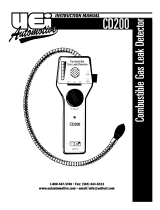 UEi CD200 Owner's manual
UEi CD200 Owner's manual
-
Dostmann GD 383 Gas-Lecksuchgerät User manual
-
UEi DTHA2 Owner's manual
-
MasterCool 56200 Operating instructions
-
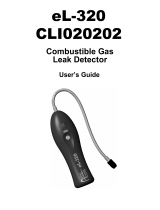 AccuTools eL-320 User manual
AccuTools eL-320 User manual
-
 WINTACT WT8820 User manual
WINTACT WT8820 User manual
-
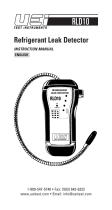 UEi RLD10 Owner's manual
UEi RLD10 Owner's manual
-
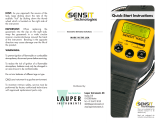 Lauper Instruments Sensit HXG-3 User manual
Lauper Instruments Sensit HXG-3 User manual
-
FLIR RD300 User manual
-
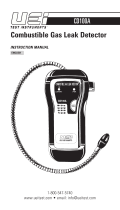 Universal Enterprises LPKITPLUS Owner's manual
Universal Enterprises LPKITPLUS Owner's manual













